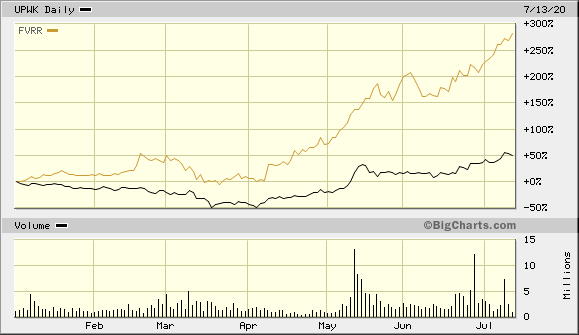There’s a dark secret Investors are completely ignoring.
As technology companies like Zoom and Slack have raced higher, but another group has quietly kept pace.
While millions have transitioned to working from home, many others have had hours cut and jobs disappear. With few companies hiring, they are turning to freelance.
Prior to COVID-19, a little over 3 in 10 people received freelance income of any amount. While we can’t know just how large that number will grow to, we do know it is going up.
But how does one find freelance work? Well, that’s the industry that’s taking advantage of this shift.
Upwork Inc. (NASDAQ: UPWK) and the newer Fiverr International Ltd. (NYSE: FVRR) dominate this relatively untapped marketplace. They run platforms that connect freelancers with clients.
Graphic designers, programmers, writers, and, many other professionals look for work on these platforms. Companies looking for blog content or website design provide opportunities.
Upwork and Fiverr, then, take 20% of the income right off the top. Everyone wins, right?
Well, investors would say so.
Upwork is the more established stock and the larger of the two. So, while its share price has shot up around 50% so far in 2020, it still lags Fiverr’s incredible 273% year-to-date performance:

How They Work
I won’t bore you with all of the intricate details of how freelancers make money on these platforms. They do it in different ways.
The short version is that Upwork allows freelancers to bid on jobs posted. Fiverr focuses on letting freelancers pitch their services.
In both cases, the platforms get their cut no matter what. Any income transferred between client and freelancer comes with a 20% haircut.
With about $2 billion in services trading hands-on Upwork in a single year, you’d think that the 20% fee would be plenty.

Grab a piece of paper and pen to write this down…
Because you’re about to see the name and ticker symbol of the ONLY 5G STOCK every investor should own.
You can get the name and ticker of this company right here, no strings attached. But you better act fast…
Because the Federal Communications Commission, the government agency in charge of 5G, just scheduled a major announcement that would send shares soaring once announced.
Don't miss out. Click Here to Get #1 5G play for 2020 before the next market close.
And with millions more looking for extra work through these platforms, 2020 would hike their profitability exponentially.
But, there is no profitability. And it gets worse the more you dig into it.
Why These Companies Fail the Sustainability Test
The idea of hosting the booming gig economy and taking $1 out of every $5 from it sounds amazing. But the whole point of the gig economy is that workers don’t have bosses anymore.
Upwork and Fiverr might be able to connect freelancers with clients. But they aren’t great at keeping them. And they know it.
Fiverr’s problem is that its original premise hasn’t evolved enough. Its catchy idea was that freelancers can sell "Gigs" for $5.
This can include anything from a website to a small logo. Great for clients, terrible for income-starved workers.
It evolved into a system with ever-increasing rates based on successes and satisfied clients. But with millions coming into the system right now, the market is flooded and rates aren’t increasing.
This means Fiverr is hurting its own 20% cut by allowing millions of more users to get paid $5 per job.
Upwork has a different problem. It has been around longer with more users. Its 20% cut never helped the company reach profitability. So, last year, it made a huge mistake. It decided to take from its freelancers.
It used to offer 60 "connections" each month. Freelancers would spend these connections on job proposals to potential clients. The system was fine. But it seemed silly. That changed in early 2019.
The company moved to a pay-per-connection system. So, now freelancers have to pay Upwork to apply for jobs. Then, they have to pay Upwork 20% of everything they make after getting jobs.
Again, with the flood in freelancers right now, those jobs just aren’t coming. So, while that means workers would theoretically need to pay more for additional connections, it’s not turned out that way. They are ditching the platform altogether.
The increases both of these companies saw in the first quarter came from new users. But, remember that those new users offer the cheapest services, which translates into fewer fees per user for the platforms.
And despite the seeming boom these two companies are seeing, neither was able to turn a profit in the first quarter.
Their path to profits isn’t even clear. The only users that could get them there are the ones charging more. But both companies have been unintentionally kicking them out in favor of cheaper, new workers.
The system is unsustainable as is. This is a surface idea that sounds great.
But the reality is different from investor hope.
It’s not even a system that offers much economic moat. These two may be the largest, but they compete with the likes of Skyword, Toptal, and Craigslist. Career-finding sites like Indeed have also been eating into market share.
Upwork’s increase so far in 2020 is not safe long term. Though, the real problem child of these two is Fiverr.
Fiverr’s platform already appeals to nonprofessionals with its Gig system. So, it will have an even harder time reaching profitability despite its record growth.
And with Fiverr’s near quadruple in the stock price in 2020, this is one company to drop immediately.
To your prosperity,
Joshua M. Belanger
Executive Publisher & Founder